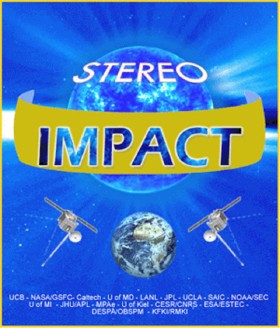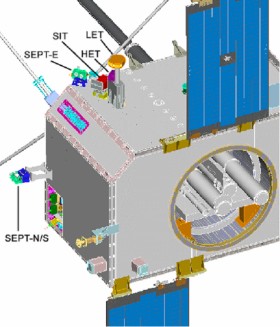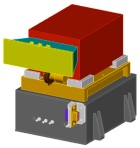IMPACT
In-situ Measurements of Particles And CME Transients
 IMPACT (In-situ Measurements of Particles And CME Transients) is a suite of seven instruments that will sample the 3-D distribution of solar wind plasma electrons, the characteristics of the solar energetic particle (SEP) ions and electrons, and the local vector magnetic field.
IMPACT (In-situ Measurements of Particles And CME Transients) is a suite of seven instruments that will sample the 3-D distribution of solar wind plasma electrons, the characteristics of the solar energetic particle (SEP) ions and electrons, and the local vector magnetic field.
Science objectives
IMPACT will be one of the STEREO mission's four measurement packages whose principal objective is to understand the origin and consequences of coronal mass ejections (CME's). CME's are the most energetic eruptions on the Sun. They are responsible for essentially all of the largest solar geomagnetic storms. The PI of the IMPACT package is Dr. Janet Luhmann.
![[Top]](/images/icons/top.gif)
The Instruments
IMPACT
 IMPACT consists of 7 instruments:
IMPACT consists of 7 instruments:
- SWEA (Solar Wind Electron Analyzer)
- STE (Suprathermal Electron Telescope)
- MAG (Magnetometer)
- SEPT (Solar Electron Proton Telescope)
- SIT (Suprathermal Ion Telescope)
- LET (Low Energy Telescope)
- HET (High Energy Telescope)
The first three of these are located on the IMPACT boom/mast that extends a total of 4.5 meters antisunward on each spacecraft. (MAG is 3 meters from the spacecraft, SWEA is at the end of the boom, at 4.5 meters).
The latter four instruments make up the SEP subsystem which is mounted on the spacecraft body. The SEP instruments are packaged together except for a part of the SEPT instrument mounted on the spacecraft at a different location for field-of \-view reasons.
Figure 2: The location of the IMPACT instrument on one of the two STEREO spacecraft
SIT
The Suprathermal-Ion-Telescope (SIT) is part of the 'In-situ Measurements
of Particles and CME Transients' (IMPACT) investigation on board the two
STEREO spacecraft. Each SIT sensor is a time-of-flight (TOF) mass spectrometer,
designed to measure the ions, protons through iron, from 20 keV/nucleon up
to several MeV/nucleon in energy.
In-situ observations of solar and interplanetary energetic particles help
us to understand the important processes involved in the acceleration and
transport of energetic particles. Since energetic particles are produced
throughout the universe, these processes are relevant not only in the
heliosphere but also in more exotic, astrophysical sites, where in-situ
measurement are not possible.
 SIT is designed to measure energetic particles produced by a wide variety
of phenomena, including particles accelerated by CME driven shocks in the
solar corona and in interplanetary space, solar flares, and corotating
interaction regions (CIRS). Because the shocks associated with CMEs are
often quite weak at 1 AU, the energy spectra produced by these shocks are
usually soft and do not extend into the MeV energy range. The large geometric
factor (0.3 cm2 sr) and low energy response of SIT makes it
well suited for observing energetic particles produced locally by these
events.
SIT is designed to measure energetic particles produced by a wide variety
of phenomena, including particles accelerated by CME driven shocks in the
solar corona and in interplanetary space, solar flares, and corotating
interaction regions (CIRS). Because the shocks associated with CMEs are
often quite weak at 1 AU, the energy spectra produced by these shocks are
usually soft and do not extend into the MeV energy range. The large geometric
factor (0.3 cm2 sr) and low energy response of SIT makes it
well suited for observing energetic particles produced locally by these
events.
Another advantage of SIT is that good mass resolution allows the composition
of the particles to be measured, thus helping to determine the source
population of the particles. Composition measurements, for instance,
are useful in distinguishing particles that are accelerated in the corona,
in interplanetary space, or at the site of solar flares.
Figure 3: Schematic diagram of the SIT sensor
![[Top]](/images/icons/top.gif)
MPS contribution on the IMPACT/SEP/SIT
SIT is an international project and part of the IMPACT instrument. SIT is led by Glenn Mason, Univ of Maryland, College Park, Greenbelt, MD. USA.
The hardware contribution from the MPS includes the following parts:
- electronic board for two amplifiers and two Constant-Fraction
discriminators for Start- and Stop pulses
- electronic board for Time to Digital Converter (TDC), Coincidence
Check plus event counter (contract: Inst. f. Datenverarbeitung,
Braunschweig)
![[Top]](/images/icons/top.gif)
The Team at MPS
Axel Korth
|
Lead Investigator |
Urs Mall
|
Co-Investigator |
Radoslav Bucik
|
Guest Scientist |
Klaus Heerlein
|
Engineers and Technicians |
![[Top]](/images/icons/top.gif)
Project status
The Engineering Model (EM) is tested and is working satisfactorily. The two Flight Model (FM1, FM2) were delivered in February and May 2004 to the University of Maryland, Greenbelt, USA. The Flight Spare Model (FS) was delivered in December 2004 to the same instution. The launch is planned for August 2006 from Cape Canaveral, FL, USA.
![[Top]](/images/icons/top.gif)
Related links
